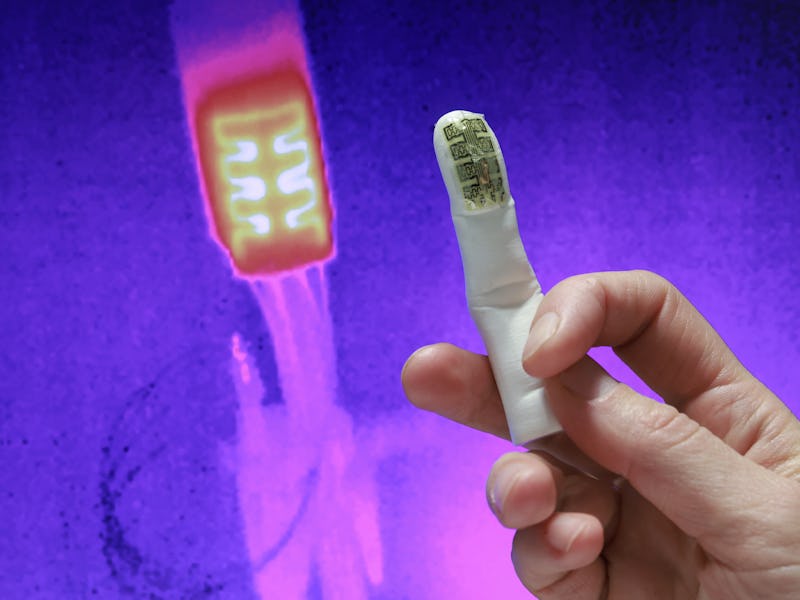A Shocking Discovery About Phantom Limb Sensations Could Revolutionize Prosthetics
“Our objective is to trick the brain into thinking that the hand is still there.”

When someone loses a limb, they might feel sensations in the region of their missing appendage as if it were still there. This phenomenon is known as a phantom limb, and it occurs in most people who lose an arm or leg. Scientists still don’t fully understand why this happens despite numerous theories. Now, a paper published today in the journal Science describes how people with phantom limb sensations can experience temperature changes. Scientists say understanding why this happens could help them create better prosthetics that include thermal sensation.
Phantom warmth
A team of researchers based in Italy and Switzerland discovered that amputees can feel temperature changes in their phantom limb. For instance, if there’s a heat source pressed to the residual limb, some people might be able to say something like, “You’re warming up my left index finger.”
Researchers have known that amputees can feel tactile sensation as well as pain in their phantom limbs, but this is the first time they’ve seen temperature detected.
“This thermal phantom sensation — that's one big surprise of this study,” says senior author Solaiman Shokur, a senior scientist at the École Polytechnique Fédérale de Lausanne (EPFL).
Using existing technology, the team says they can enable thermal abilities in prosthetics. The team developed a new piece of equipment they call the MiniTouch, which is a portable device that allows amputees to detect temperature through their prosthetic limb.
“Our objective is to trick the brain into thinking that the hand is still there,” says first-author Francesco Iberite, a Ph.D. candidate at the Scuola Superiore Sant’Anna BioRobotics Institute in Italy. “Being able to have sensation on the phantom hand is fundamental for this.”
The patient refers the sensation felt during the thermal stimulation.
A more embodied life
A prosthetic that detects temperature can create a more natural feeling of embodiment. Iberite says that a sense of a prosthetic belonging to their body tends to be an issue among users. “Even using a very sophisticated arm, they don't feel that arm as part of them,” he tells Inverse.
Further, this tool can also register what’s known as affective touch, which is what triggers the release of the so-called love hormone oxytocin in the brain. Affective touch is a kind of tactile perception that differs from mechanical touch, which receives messages about pressure, texture, and vibrations. Affective touch, on the other hand, can carry emotionally charged information that comes in handy in social cues.
Fabrizio Fidati showing, on a drawing of a hand, where he feels the temperature sensation from the MetaTouch device.
Mapping unseen hands
The team performed several experiments with a group of 27 people to gauge someone’s ability to feel temperature in their phantom limb. The first experiment probed for what the team calls “thermal phantom hand maps” in participants, which involved attaching thermal electrodes from a device called a MetaTouch to various spots on the residual limb where the amputation had occurred.
In the event of a thermal phantom hand map, the participant would be able to pinpoint where a temperature change occurred on their phantom limb. Menthol, for example, would be applied to the residual limb and participants would respond with precise statements like, “I feel you are cooling down my left index finger,” as the paper reports. This finding establishes the existence of thermal detection in phantom limbs. Seventeen of the 27 participants had this hand map, and the researchers for now extrapolate that a similar portion of the amputee population may have this map.
Next, they tested for what they call phenomenology in eight participants, or whether something has a natural feeling. The participants held copper, plastic, and glass samples in their intact hand while also feeling the same materials mediated through the MetaTouch attached to their residual limb.
In a third round, they showed that the MiniTouch is a successful prosthetic addition that works to mediate temperature and be carried around. It’s meant to be integrated with existing prosthetics. “It’s a skin that comes on top of it, which mimics the thermal sensation of human skin,” Shokur says.
Solaiman Shokur explains the thermal phantom sensation.
Protecting the sensation
The MiniTouch is still a ways away from commercialization. Further, there is a lot that researchers still don’t fully understand about phantom limbs. For instance, when a limb is amputated, the nerve endings grow back and reintegrate into the tissue around them. However, this is an uncontrolled process. It’s uncertain which or to what degree someone will regain their tactile senses in their residual limb.
“Our next step is to test that on the longer term,” Shokur tells Inverse. While he and his team want larger trials of the MiniTouch, they’d also like longer ones to prove that this sensation can be sustained over months. The team has already confirmed that a significant portion (about 60 percent of their cohort) can detect these sensations, but questions remain about the long-term usage of this tool.
“What we don't know is what happens to their brain after a long-term use,” Iberite says. Likewise, a study over weeks or months will help shore up the MiniTouch as a piece of equipment.
Compared to other sophisticated prosthetics, Shokur says the price of the MiniTouch would be relatively cheap. “It's really negligible compared to what a robotic prosthetic hand costs, for example,” he says. Bionic hands can cost tens of thousands of dollars.
These researchers understand that a phantom limb isn’t something to be done away with but to be integrated. The discovery that phantom limbs register temperature changes creates another avenue for helping amputees adjust. The MiniTouch could help return a sense of embodiment to those who use prosthetics after losing a limb.
“I think it could help them feel more in contact with the things around them,” Shokur says.
This article was originally published on